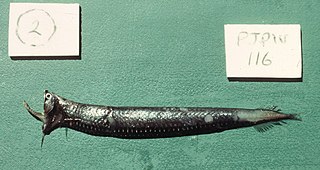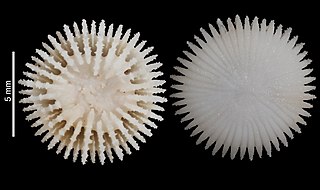
James Wood-Mason was an English zoologist. He was the director of the Indian Museum at Calcutta, after John Anderson. He collected marine animals and lepidoptera, but is best known for his work on two other groups of insects, phasmids and mantises.

Alfred William Alcock was a British physician, naturalist, and carcinologist.

The quagga catshark is a species of catshark, belonging to the family Scyliorhinidae. A small, slim-bodied shark reaching 37 cm (15 in) in length, it has a distinctive color pattern of narrow, dark brown vertical bars, which resemble those of the quagga. Its head is short and flattened, with a pointed snout tip that is not upturned.

Munidopsis is a genus of squat lobster. It is the second largest of all the genera of squat lobsters, after Munida, with over 200 species. Its members are mainly found on continental slopes and on abyssal plains. A few fossil species are also known, including specimens from the Campanian (Cretaceous).

Munida is the largest genus of squat lobsters in the family Munididae, with over 240 species.

Metapenaeopsis, the velvet shrimps, is a prawn genus in the family Penaeidae. It contains these species:

Uroptychus is a genus of squat lobsters in the family Chirostylidae found across the Indo-Pacific. The genus Uroptychus contains the following species:

Stomias is a genus of barbeled dragonfishes. They live in the mesopelagic zone of all oceans and show diel vertical migration and sexual dimorphism (males are smaller, have larger eyes and larger postorbital photophores than females.

Scopelarchus is a genus of pearleyes.
Porogadus is a genus of cusk-eels.

Balanophyllia is a genus of solitary corals in the order of stony corals.

Leptopsammia is a genus of stony cup corals in the family Dendrophylliidae. Members of this genus are found at depths down to about 900 metres (3,000 ft). They are azooxanthellate, meaning that they do not contain symbiotic photosynthetic algae as do many species of coral.

Dendrophyllia is a genus of stony cup corals in the family Dendrophylliidae. Members of this genus are found at depths down to about 900 metres (3,000 ft). They are azooxanthellate corals, meaning that they do not contain symbiotic photosynthetic dinoflagellates as do many species of coral.

Conotrochus is a genus of small corals in the family Caryophylliidae. It holds four species.

Flabellum is a genus of marine corals belonging to the family Flabellidae. These are a diverse group of azooxanthellate corals with about 190 species, 47 of which are extant. They are exclusively solitary corals and many are deep water species.

Goniocorella is a genus of cnidarians belonging to the family Caryophylliidae.

Enallopsammia is a genus of cnidarians belonging to the family Dendrophylliidae.

Eguchipsammia is a genus of corals belonging to the family Dendrophylliidae.

Trochocyathus is a genus of corals in the family Caryophylliidae. Living species are found in waters near Hawai'i at depths of 64 to 1,020 meters. Fossil species are found as far back as the latest Paleocene in the Dilwyn Formation of Australia, in the late Cretaceous in the Woodbury Formation of New Jersey, and in Suffolk.

Anthemiphyllia is a genus of corals within the family Anthemiphylliidae. There are currently 8 extant and 2 extinct species assigned to the genus.




















